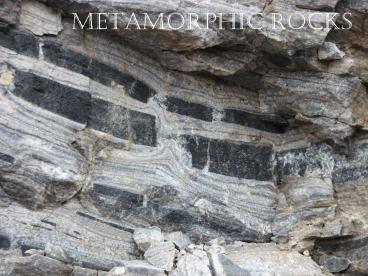Metamorphic Rocks - PowerPoint PPT Presentation
1 / 25
Title: Metamorphic Rocks
1
Metamorphic Rocks
2
Change While Still Solid!!
- Changes in
- Pressure
- Temperature
- Composition
- Cause changes in
- Mineralogy
- Crystal size
- Rock Texture
- Ex Firing clay to make ceramic
3
Molecular Connections
- All atoms move (as do the bonds between them)
down to -273 C - More energy, more movement rubber bands
4
Composition (mineral) changes
- Talc ? Anthophyllite, Quartz, and H2O
5
From Rock to Rock?
- Can change in texture
- Or crystal size
6
How Crystals Grow In Solids
- Must steal ions from existing grains SLOW
- Unlike fluids (magma), cant get rid of unwanted
ions - Faster along crystal boundaries, or where water
or another fluid is present
7
A Range of Environments
- Geothermal gradient change in T with depth
- Average 30C/km
- Major deviations from common pressure/temperature
vs. depth gradients can cause metamorphism
8
T P Increase with depth
9
So
- Changes in the rock depend on the minerals
present in the original rock - Each mineral is only stable in a certain T, P,
and chemical environment
Metamorphic Grade
10
Metamorphic Grade
11
Changes in Temperature (T)
- Every mineral is stable within a certain
temperature range - Some, like the micas, contain water, which boils
off at high T, changing to a new mineral - Over a long time, if heat is elevated but below
melting point, bonds link in new 3D structures - Crystals will grow larger because bonds are
relaxed
12
T is the Great Destroyer
- Both are composed of the mineral calcite (CaCO3)
- Growth of minerals in high T destroys fossils
13
Contact Metamorphism
- Highest grade changes closest to magma
- Diminishes with distance
- Randomly oriented
- crystals
Hot igneous rock (magma)
Note these rocks are unaffected
14
Pressure (P)
- Every mineral is stable within a certain pressure
range - Burial metamorphism
- Progressive build-up of sediment causes an
increase in T and P with depth - As P increases, denser crystals form
- Common along East, Gulf Coasts (deep)
15
If P is uniform
- Lithostatic pressure due to
overburden - Results in reduction in crystal size
- Randomly oriented crystals form
Uniform Stress
16
If P in non-uniform
- New platy minerals (ex mica!) grow perpendicular
to the direction of pressure - Old minerals rotate perpendicular
Parent
Post-metamorphosis
17
Granite
Gneiss (in this case, metamorphosed granite)
18
Foliation
Weakly foliated
- Set of flat or wavy parallel planes
- As the grade increases, so does the distinctness
of the foliation
Strongly foliated (note increase in grain size
due to elevated T)
19
Regional Metamorphism
- Most common and widespread type
- Occurs in areas where Earths crust is squeezed
(Himalayas ? India and Asia) - Usually associated with volcanoes/plutons
Metamorphism ends where melting begins
20
Increasing grade of metamorphism of volcanic rock
under directed pressure and elevated T.
Reduction in grain size, growth of elongated
crystals perpendicular to stress direction,
minerals segregate into layers. High T eventually
grows large crystals.
21
Metamorphism Involving Fluids
- Hot water moves along grain boundaries and then
in cracks opened by water P - Derived from water bound in minerals
- Contains lots of dissolved ions
- When it moves through a rock body, its ions often
exchanged with ions/atoms in rocks - Most rocks and magma have small quantities of
metal ions (gold, silver, copper, lead, zinc,
uranium) - Water can collect these ions and concentrate them
- All precious metal deposits form this way
- Randomly oriented crystals
22
Black Smokers and Seafloor Metamorphism
23
Metamorphic Facies
- Different kinds of metamorphic rocks are formed
from parent rocks of different composition at
same metamorphic grade - Your parents mean a lot
- Determine the kind of elements available
24
Metamorphic Facies
- 2. Different kinds of metamorphic rocks are
formed under different grades of metamorphism
from parent rocks of the same composition
25
How do Rocks Reach the Surface?
- Only radiation grows legs so
- If changes in P, T, and composition can cause
metamorphism, then slow changes to shallow depths
would be problematic - Rapid uplift and exposure but how?
- Evidence suggests that rapid erosion drives rocks
to the surface































